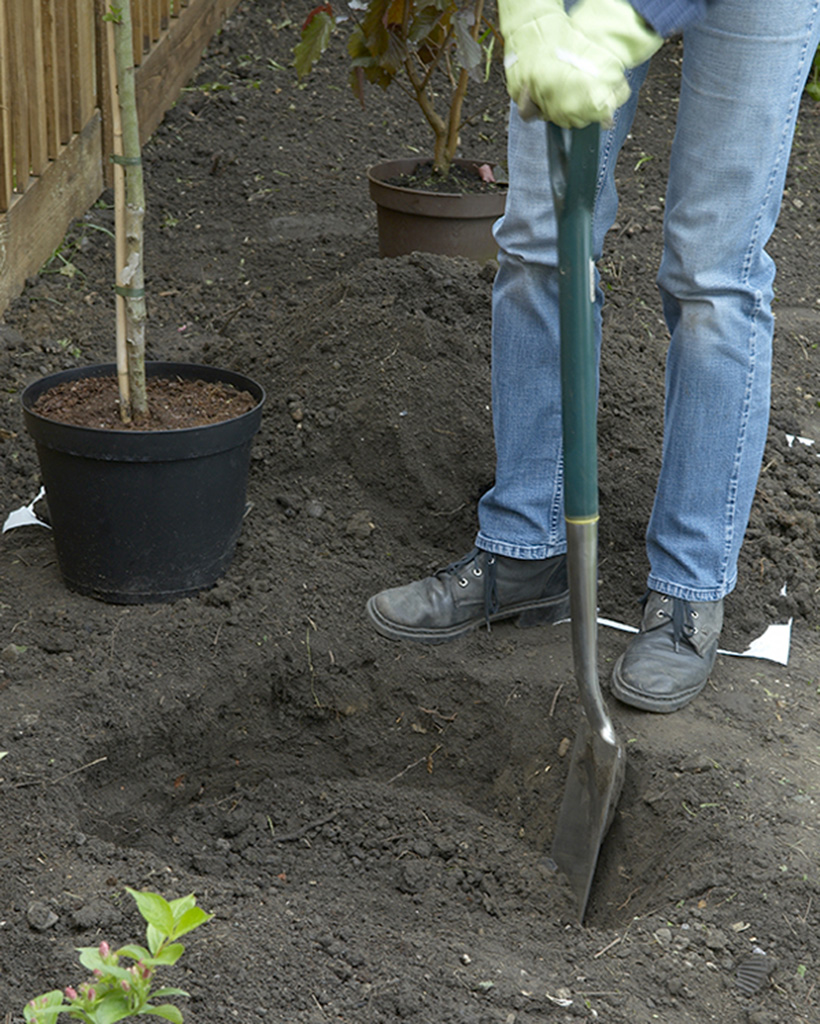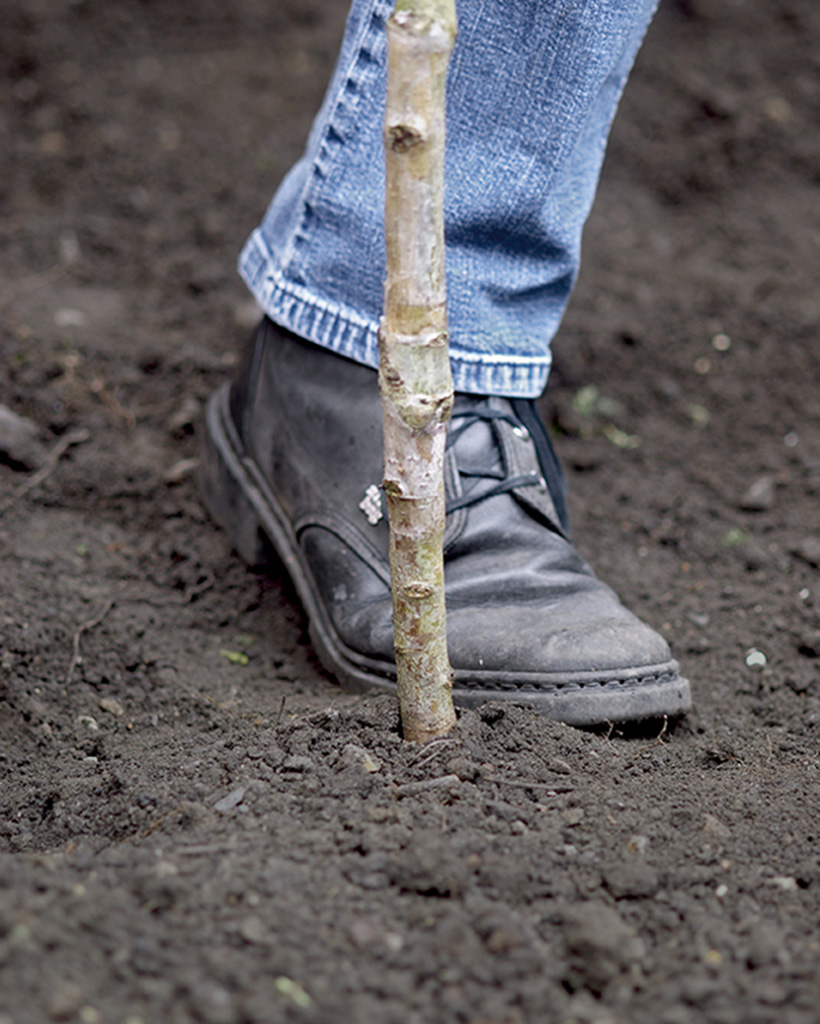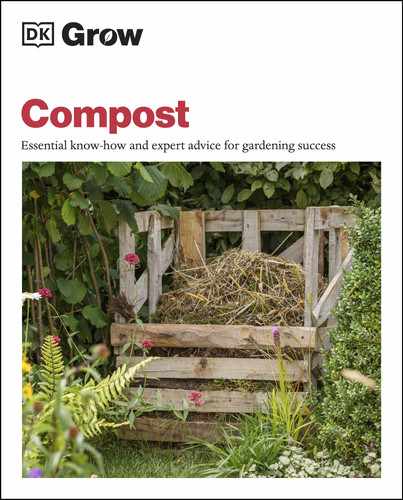PLANTING TREES AND SHRUBS
Trees and shrubs make a valuable contribution to any garden, offering height, structure, color, and shade. They also perform an important role in reducing air pollution by absorbing large volumes of carbon dioxide, which contributes to global warming, and releasing oxygen back into the atmosphere. Your homemade compost and leaf mold will help to get these plants off to a good start.

Himalayan birches (Betula utilis), with their gleaming white stems and airy canopies of diamond-shaped leaves, are a good choice for small gardens.
CHOOSING TREES AND SHRUBS
Before buying a tree or shrub, assess your garden conditions, including the soil type and how much sun and shade it receives, to ensure that the plants you have in mind will thrive there. Also check each plant’s final height and spread to make sure it will not outgrow the space allocated for it, since moving a mature tree or shrub from the wrong position is not an easy task. In a small garden, opt for a tree that has a few seasons of interest, such as spring blossom and autumn fruits or colorful leaves. Compact cherry (Prunus), crab apple (Malus), and hawthorn trees (Crataegus) are ideal, or opt for an evergreen such as holly (Ilex), which will decorate the garden with glossy leaves all year and red berries in autumn and winter. Consider a tree’s shape, too; a tall, slim specimen may work better in a small space than a shorter, broader plant. Scented shrubs, including mahonias, daphnes, sweet box (Sarcoccoca confusa), and Viburnum carlesii will also add to the sensory delights of the garden. A nursery specializing in trees and shrubs can advise you on other good choices for your specific site and needs.
TOP TIP POT-GROWN SHRUBS CAN BE PLANTED AT ANY TIME OF THE YEAR, BUT AVOID THE SUMMER MONTHS WHEN THE SOIL IS DRY AND PLANTS WILL NEED WATERING MORE FREQUENTLY.

Hawthorns are compact trees with pretty spring blossoms that are loved by pollinators, followed by red autumn berries.
BEFORE PLANTING
Most trees and shrubs thrive in a water-retentive soil that also drains well, which are the exact conditions a mulch of homemade compost will deliver. The best time to plant a bare-root tree or shrub is in autumn; ideally, you should apply a mulch to the proposed site a year beforehand so that the worms have time to bring it down into the soil and improve its structure. If this is not possible, mix some compost with the soil you have excavated when digging the planting hole. Avoid planting when the soil is frozen, waterlogged, or bone-dry.

Hardy shrubs such as Viburnum carlesii, which produces its scented flowers in spring, are best planted in autumn.
Compost Planting Projects | PLANTING TREES AND SHRUBS
PLANTING A TREE OR SHRUB

1 Plant shrubs at the same level as they were growing in their pots or the soil (look for the dark soil mark on the stems of bare-root plants). Trees should be planted at the same level or slightly proud of the surface. Dig a hole to the depth of the root ball and three times as wide. Loosen the sides of the hole with a fork if the soil is compacted.
Compost Planting Projects | PLANTING TREES AND SHRUBS

2 Tease out the roots of plants grown in pots to help them grow away more easily, and trim off any black or damaged roots from bare-root types.
Compost Planting Projects | PLANTING TREES AND SHRUBS

3 Place the plant in the hole and use a cane to check it is at the right depth. Refill the hole with the excavated soil, and compost if using it at this stage (see Before Planting).
Compost Planting Projects | PLANTING TREES AND SHRUBS

4 Use your toe to press the soil down around the stem to remove any air pockets. Water well and then apply a 2–3in (5–7.5cm) mulch of shredded mature wood chips (see also Mulching Problems and Solutions for advice on using wood chips), well-rotted compost, or one-year-old leaf mold on the soil over the root ball, leaving a 4in (10cm) gap around the stem.
Compost Planting Projects | PLANTING TREES AND SHRUBS
STAKING AND AFTERCARE
Large trees or those planted in windy sites will need staking after planting. Hammer in a stake at a 45-degree angle on the side of the tree opposite to the prevailing wind direction, making sure that about one-third of its length is beneath the ground. Secure it to the stem with a tree tie and remove it only when the root ball no longer moves as you gently shake the tree stem. Water all newly planted trees and shrubs regularly during dry spells for 3–5 years after planting to ensure good root growth. Drench the area well once or twice a week so that water percolates down to the roots at lower levels, rather than giving small quantities more often, which encourages roots to grow toward the surface where the soil is drier and they will be more prone to drought stress. Mulch around your tree or shrub with your homemade products (see step 4) every year, in autumn on clay soils or in spring on lighter sandy soils.

Use a tree tie to secure the trunk to the stake and loosen it as the tree grows.
